Lumps and Bumps: Common Equine Skin Masses
The appearance of a lump on your horse where there previously was nothing but soft shiny coat, can be very disconcerting. Besides the common hives and bug bites, horses can develop tumors of the skin as well. Knowing what type of skin mass your horse has will allow for quick application of appropriate therapy and greatly improve prognosis.
The three most common types of skin mass or cancer in horses are:
- Sarcoids
- Melanomas
- Squamous Cell Carcinoma
Sarcoids
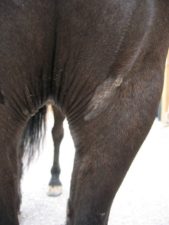 Sarcoids are benign tumors, this means that they are unlikely to aggressively invade normal tissues and that a complete removal of the tumor can be curative. There are four main types of sarcoids:
Sarcoids are benign tumors, this means that they are unlikely to aggressively invade normal tissues and that a complete removal of the tumor can be curative. There are four main types of sarcoids:
- Occult — hairless, rough, circular patches of skin
- Verrucous — wart-like lumps, crusty looking
- Nodular — raised bumps that feel firm when touched
- Fibroblastic — irregular shaped lumps that bleed easily and are soft to the touch.
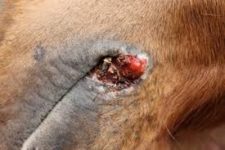 An individual horse can have just one sarcoid, many sarcoids that are all the same type, or one of each kind! Common areas for sarcoids to appear are on the face and legs but they can appear anywhere on the body.
An individual horse can have just one sarcoid, many sarcoids that are all the same type, or one of each kind! Common areas for sarcoids to appear are on the face and legs but they can appear anywhere on the body.
There are many different treatments for sarcoids depending on location, size and variety of sarcoid. It should be acknowledged that all treatments come with their own risks, and should be chosen carefully.
- Benign neglect — when the sarcoid is not causing any pain or discomfort to the horse, we may choose to simply monitor the sarcoid to see if there are any changes
- Surgical removal — depending on type, location, and size, total surgical removal may be possible
- Topical Therapy- there are some creams that can be applied topically to stop the spread of the sarcoid cells
- Immunotherapy- in some cases, treatment with immunostimulant shots will increase the likelihood that the body’s own immune system will destroy the sarcoid cells
Melanomas
Melanomas are usually seen on grey horses. These round black lumps are most commonly found under the tail, on the udder or sheath, and around the lips and face. Melanomas can be benign or malignant. Malignancy — where the cancer spreads to other parts of the body, namely other organs —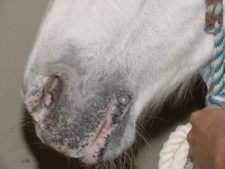 is usually seen in older grey horses.
is usually seen in older grey horses.
Due to the higher incidence of aggressive lesions, treatment for melanoma is generally more invasive than for sarcoids. Options include: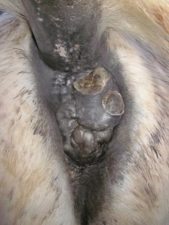
- Surgical excision — if the cancer is a singular lump, on a young horse this treatment can be most effective
- Intralesional cisplatin — cisplatin is a chemotherapy drug that is injected into the melanoma to kill the cancer cells.
- Melanoma vaccine — this is a vaccine that is currently being tested for use in horses after good results in human medicine.
Squamous Cell Carcinoma (SqCC)
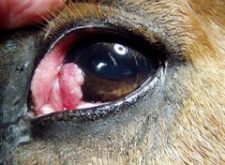 SqCC is the most aggressive of the three common equine skin masses. They look like irregular lumps with a pimple
SqCC is the most aggressive of the three common equine skin masses. They look like irregular lumps with a pimple
like appearance or can be bright red and ‘angry’ looking. SqCC can be big or small, usually malignant and is most
often seen on non-pigmented horses around the mouth, eyes, and under the tail. It is most commonly seen in
Appaloosas, Belgians, American Paints, and Pintos.
Treatment for this aggressive tumor is therapy that hits the cancer hard and fast to stop growth and kill the cells at the same time.
- Chemotherapy- topical or injectable drugs used to stop cancer cell growth
- Cryotherapy — freeze the tumor quickly and thaw slowly — works in the same manner as frostbite.
- Radiotherapy — using radiation to the affected areas
- Surgical removal — based on location, size and surgeon’s opinion.
These three skin tumors are most commonly seen in horses. Not all treatments work on all horses, and if a horse has had any of the types of cancer, even if treated and totally removed, it is still possible to for the mass to return in the same area. If your horse develops a new lump or bump, always have it examined by your veterinarian so that a correct diagnosis can be made and proper therapy started in a timely manner.